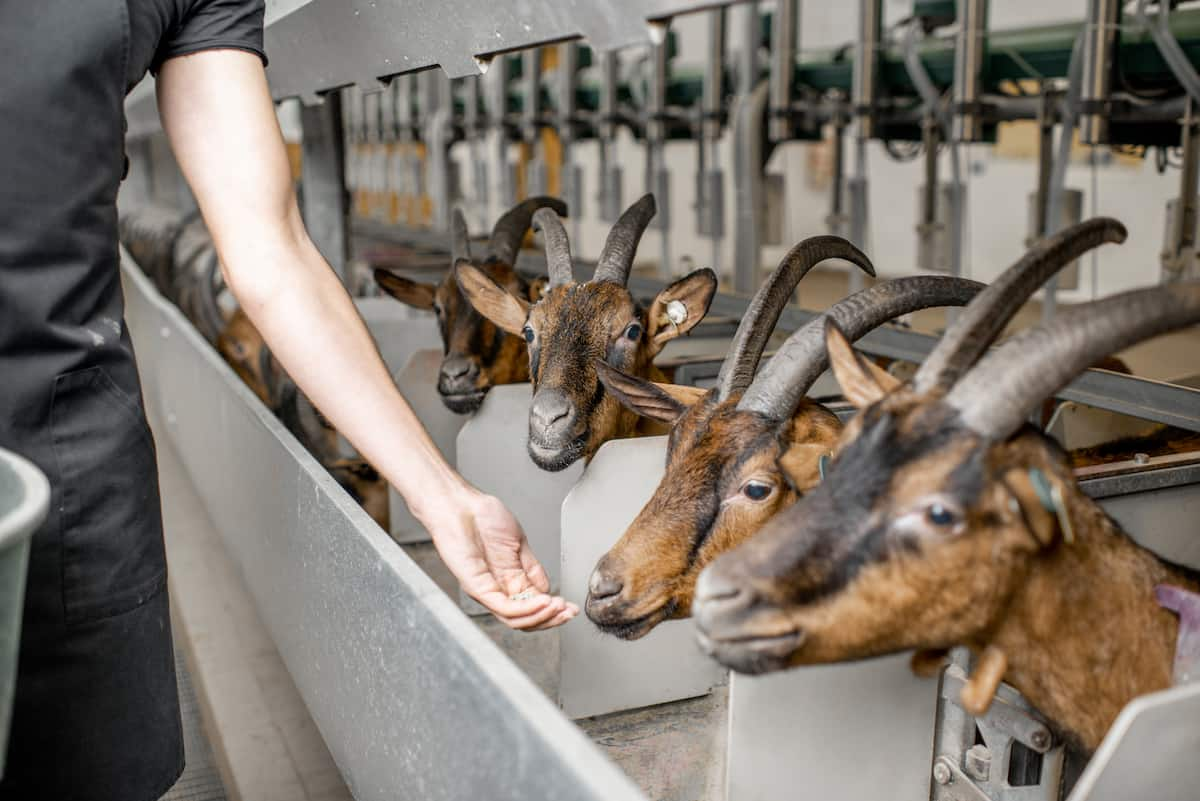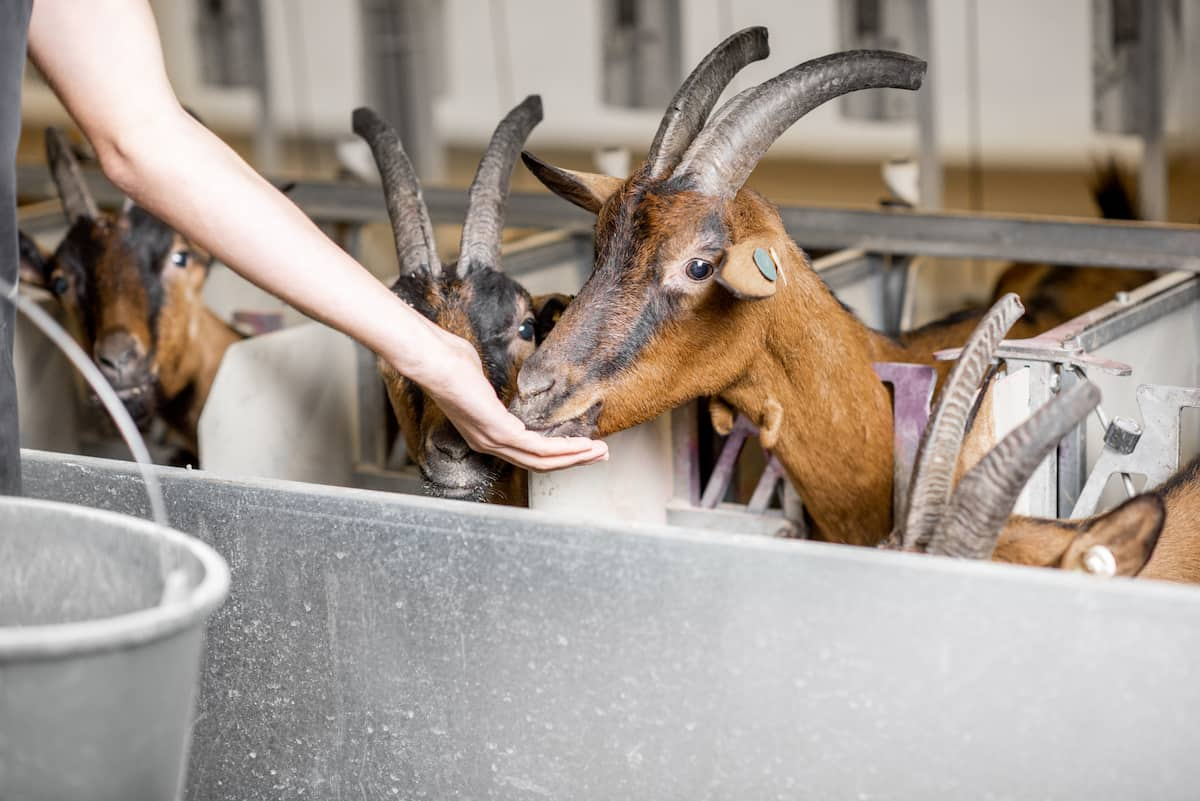Goats are important livestock animals raised for milk, meat, and fiber. Providing goats with proper nutrition and feeding strategies is essential to ensure optimal health and productivity. Goats need the right mix of nutrients, vitamins, and minerals to build and keep up healthy immune systems, strong bones, and good milk production.

In addition, understanding the different types of feed components, such as hay, pasture, grains, and supplements, and implementing effective feeding strategies is key to achieving the best results. This blog post will provide tips and advice on goat nutrition and feeding strategies, including common feeding issues and solutions, to help ensure your goats remain healthy, productive, and thriving.
Goat Nutrition Tips and Feeding Strategies
The Importance of Proper Nutrition for Goat
- Water is essential to goats, and they should always have free access to fresh, clean water. They are efficient in their water use but can become dehydrated quickly if they do not have enough to drink.
- Energy requirements for goats depend on age, body size, and stage of life. Energy deficiencies can occur if goats are not getting enough food or their diet is poor.
- Protein is critical for many body functions, and deficiencies can lead to serious health problems. Goats generally get enough protein from their diet, but lactating, growing, or sick animals may require more protein.
- Goats’ mineral requirements are similar to sheep’s, and a well-balanced diet that meets their needs can help them optimize their production and immune system. Calcium and phosphorus are two elements that goats require in large amounts.
- Feeding practices should consider lactation, environmental temperature, and exercise. A standardized body condition score can help monitor body fat changes and decide dietary adequacy.
Nutrition and Feeding for Goat
Goats are excellent foragers that can eat anything from grass to shrubs. Proper nutrition and pasture management are essential for maintaining a healthy herd.
- Providing free-range access to pastures is crucial for proper nutrition.
- During the winter months, when grazing ground is unavailable, hay is an essential source of nutrients for goats.
- Grains can also be used as a supplement to extend the grazing season or boost nutrient levels, but overfeeding can lead to health problems.
- Mineral supplements are often required since forages don’t contain enough minerals to meet goats’ dietary requirements.
- Fresh and clean water must always be readily available to goats.
- With proper rotational grazing, goat producers can increase pasture production and control parasites.
- High-quality pastures provide excellent goat feed that can also stimulate milk production during kidding.
Nutrition and Feeding Strategy in Goat Rearing
- Goats raised for meat require high-quality feed and an optimum balance of nutrients to achieve maximum profit potential. Therefore, developing a year-round forage program that allows for grazing as much as possible throughout the year is important.
- Feeding goats low-quality feed will not lead to successful meat goat production, as they require a higher quality diet than cattle due to their smaller digestive tract size.
- Because goats avoid eating the stems, can detoxify tannins, and profit from the comparatively high levels of protein and cell solubles found in these plants’ leaves, goats can digest low-quality roughage sources, such as trees and shrubs, that cattle cannot.
- Goats need nutrients for bodily upkeep, growth, reproduction, pregnancy, and the creation of goods like meat, milk, and hair. These basic elements include vitamins, minerals, energy, protein, and water.
- Goats are based according on their nutritional requirements for more efficient feed management. Bucks, young goats, and does at various growth and production phases have different nutritional requirements.
- Animals with the greatest nutritional needs should have access to lush, leafy forage or premium browse when pasture is available. These same animals should be provided with the best hay accessible when being fed in a barn, such as in the winter.
- When the hay they are given or the forage they are grazing does not contain enough nutrients to meet their nutritional needs, goats should be supplemented with concentrated feed.
- Producers can better match demands with suitable forages by comparing nutrient requirements to feeds’ chemical makeup. Good forages comprise between 55 and 70% TDN, good forages between 40 and 55% TDN, and concentrate feeds between 70 and 90% TDN.
In case you missed it: Benefits of Goat Manure Fertilizer in Agriculture and How to Apply

Tips and Advice on Goat Nutrition Components
Water
Water is a cheap feed ingredient, but insufficient water can affect the production and growth of goats. Water requirements depend on the production stage and environmental conditions. It’s important to provide goats with clean and safe water to avoid potential toxicity from blue-green algae found in stagnant water. Safe nitrate levels in drinking water should be less than 100 for nitrate nitrogen, less than 443 for nitrate ion, and less than 607 for sodium nitrate.
Energy
Goats can obtain the necessary energy from carbohydrates and fats. A diet consisting of lush leafy forage, browse, and tree leaves can provide enough energy to meet the nutrient requirements of all goats on the farm. High-energy grains such as cottonseed, corn, wheat middling, soybean meal, soybean hulls, and corn gluten feed can also be fed to provide the required energy. However, due to efficiency concerns, the diet’s fat quantity should be limited to at most 5%.
Protein
Goats need protein, but it can be expensive. Lush forage, browse, and tree leaves provide enough protein for all goats. Grains high in protein, like cottonseed and soybean meal, can also be used. Insufficient protein affects growth, milk production, reproduction, and disease resistance. Excess protein is excreted in urine as urea and not stored in the goat’s body.
Minerals
Goats require a range of minerals for optimal health and production. Salt, calcium, phosphorous, and magnesium may be deficient in their diet, as well as trace minerals like selenium, copper, and zinc. Giving your goat a complete mineral or a mix of mineralized salt and dicalcium phosphate is best. The calcium-to-phosphorous ratio should be maintained between 2:1 and 3:1. Grass tetany can occur during early lactation on certain pastures. Copper toxicity may affect young, nursing kids more severely.
Nutritional Management in Different Age Groups Goats
- Colostrum is the first milk made after birth and contains immunoglobulins, vitamins, minerals, and other energy sources. Children should consume 10% of body weight in colostrum for optimal immunity within the first 12-24 hours of birth.
- Only the first milking of healthy animals should be frozen for later feeding, and colostrum from older animals has a higher antibody concentration against endemic pathogens.
- The replacement needed for breeding should be grazed with their mothers during the milking period as much as possible and not weaned early.
- During late pregnancy, nutritional requirements are high, especially if the pregnant doe carries more than one fetus. Adequate amounts of feed cannot be consumed due to abdominal crowding; thus, does feed a poor-quality diet can develop Ketosis and death. Grain and protein meals are the preferred feeds to overcome this problem.
- Producers should be concerned with their animals’ body condition as reproductive failure can result if they are under or over-conditioned during breeding.
In case you missed it: Frequently Asked Questions About Goat Farming

Conclusion
To ensure optimal health and performance, goat nutrition should include a balanced diet of forages, grains, supplements, clean water, and appropriate minerals. Feeding strategies should consider age, gender, breed, and activity level, and adjustments should be made to meet individual needs.
- Feed Your Flock for Less: Top 10 Tips to Save on Chicken Feed
- Ultimate Guide to Ossabaw Island Hog: Breeding, Raising, Diet, and Care
- Hatching Answers: The Top 10 Reasons Your Chickens Aren’t Laying Eggs
- Eggs and Economics: Breaking Down the Cost of Raising Backyard Chickens
- Defend Your Greens: Proven Methods to Keep Iguanas Out of Your Garden
- Ultimate Guide to Cinnamon Queen Chicken: A Comprehensive Guide for Beginners
- Ultimate Guide to California Tan Chicken: Breeding, Raising, Diet, Egg-Production and Care
- Ultimate Guide to Marsh Daisy Chicken: Breeding, Raising, Diet, and Care
- 10 Types of Chicken Farming Businesses You Can Start for Profits